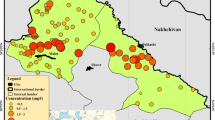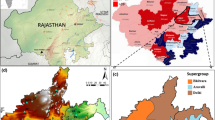Abstract
Like many elements, fluorine (which generally occurs in nature as fluoride) is beneficial to human health in trace amounts, but can be toxic in excess. The links between low intakes of fluoride and dental protection are well known; however, fluoride is a powerful calcium-seeking element and can interfere with the calcified structure of bones and teeth in the human body at higher concentrations causing dental or skeletal fluorosis. One of the main exposure routes is via drinking water and the World Health Organisation currently sets water quality guidelines for the element. In Central Europe, groundwater resources that exceed the guideline value of 1.5 mg l−1 are widespread and effects on health of high fluoride in water have been reported. The aim of the current project was to develop a geographic information system (GIS) to aid the identification of areas where high-fluoride waters and fluorosis may be a problem; hence, where water treatment technologies should be targeted. The development of the GIS was based upon the collation and digitisation of existing information relevant to fluoride risk in Ukraine, Moldova, Hungary and Slovakia assembled for the first time in a readily accessible form. In addition, geochemistry and health studies to examine in more detail the relationships between high-fluoride drinking waters and health effects in the population were carried out in Moldova and Ukraine demonstrating dental fluorosis prevalence rates of 60–90% in adolescents consuming water containing 2–7 mg l−1 fluoride.




Similar content being viewed by others
References
Apambire, W. B., Boyle, D. R., & Michel, F. A. (1997). Geochemistry, genesis and health implications of fluoriferous groundwaters in the upper regions of Ghana. Environmental Geology, 33(1), 13–24.
Bartram, J., & Balance, R. (1996). Water quality monitoring, a practice guide to the design and implementation of freshwater quality studies and monitoring programmes. London: E&F Spon.
Biro, G., Antal, M., & Zajkas, G. (1996). Nutrition survey of the Hungarian population in a randomized trial between 1992–1994. European Journal of Clinical Nutrition, 50, 201–208.
Brown, W., & Konig, K. G. (1977). Cariostatic mechanism of fluorides. Caries Research, 11(Suppl 1), 1–327.
Dean, H., Arnold, F., & Elvove, E. (1942). Domestic water and dental caries. V. Additional studies of the relation of fluoride in domestic waters and dental caries. Public Health Report, 57, 1155–1179.
Dissanayake, C. B. (1996). Water quality and dental health in the Dry Zone of Sri Lanka. In J. D. Appleton, R. Fuge, & G. J. H. McCall (Eds.) Environmental geochemistry and health with specific reference to developing countries. London: Geological Society (pp. 131–141) Geological Society Special Publication 113.
Dissanayake, C. B., & Chandrajith, R. (1999). Medical geochemistry of tropical environments. Earth Science Reviews, 47(3–4), 219–258.
Edmunds, W. M., & Smedley, P. M. (1996). Groundwater geochemistry and health—an overview. In J. D. Appleton, R. Fuge, & G. J. H. McCall (Eds.), Environmental geochemistry and health with specific reference to developing countries London: Geological Society (pp. 91–107). Geological Society Special Publication 113.
Fordyce, F. M., & Vrana, K. (Eds.) (2001). Development of a fluoride risk assessment GIS for Central Europe. Final Report: Water Quality Improvements through Fluoride Reduction in Groundwater of Central Europe. Inco-Copernicus 15-CT98-0139.
Frencken, J. E., Truin, G. J., Van’t Hof, M. A., Konig, K. G., Mabelya, L., Mulder, J., & Ruiken, H. M. (1990). Prevalence of dental caries in 7–13-yr-old children in Morogoro District, Tanzania, in 1984, 1986, and 1988. Community Dental Oral Epidemiology, 18(1), 2–8.
Fuge, R. (1988). Sources of halogens in the environment, influences on human and animal health. Environmental Geochemistry and Health, 10(2), 51–61.
Gabovych, R., & Minkh, A. (1979). Hygienic problems of drinking water fluoridation. Moscow: Meditsina.
Gabovych, R., & Ovrutsky, G. (1969). Fluoride in stomatology and hygiene. Kazan: Tatpoligraph.
Gnatyuk, P. (1988). Fluorosis and caries of temporal teeth. Stomatology, 67(5), 67–68.
Grigoryeva, L., Golovko, N., Nikolishiyn, A., & Pavlyenko, L. (1993). Fluoride influence on prevalence and intensity of stomatological disease in adolescents of Poltava Oblast. In Conference proceedings—fluoride problems of ecology, biology, medicine and hygiene. Poltava, pp. 25–26.
Groshikov, M. (1985). Non-caries injuries of dental tissues. Moscow: Meditsina.
Health Protection Ministry. (1999). Norms of physiological needs of Ukrainian population in main food nutrients. Kiev: Health Ministry of Ukraine Decree 272.
Hem, J. (1992). Study and interpretation of the chemical characteristics of natural water. Reston: US Geological Survey.
Jacks, G., Rajagopalan, K., Alveteg, T., & Jonsson, M. (1993). Genesis of high-F groundwaters, southern India. Applied Geochemistry (Suppl 2), 241–244.
Jarup, L. (2004). Health and environmental information systems for exposure and disease mapping and risk assessment. Environmental Health Perspectives, 112(9), 995–997.
Jenkins, G. (1967). The mechanism of action of fluoride in reducing caries incidence. International Dental Health, 17, 385–390.
Jowsey, J., & Riggs, B. (1978). Effects of concurrent calcium ingestion in intestinal absorption of fluoride. Metabolism, 27, 971–974.
Kajaba, I., & Bucko, A. (1968). Health and nutritional status of children in an industrialised and agricultural area of Eastern Slovakia. III. Investigations of the lipid metabolism. Reviews of Czech Medicine, 14(3), 180–191.
Krishnamachari, K. (1986). Skeletal fluorosis in humans—a review of recent progress in the understanding of the disease. Progress in Food and Nutrition Science, 10(3–4), 279–314.
Lahermo, P., Sandstrom, H., & Malisa, E. (1991). The occurrence and geochemistry of fluorides in natural waters in Finland and East Africa with reference to their geomedical implications. Journal of Geochemical Exploration, 41, 65–79.
Li, Y., Liang, C. K., Katz, B. P., Niu, S., Cao, S., & Stookey, G. K. (1996). Effect of fluoride exposure and nutrition on skeletal fluorosis. Journal of Dental Research, 75(SISI), 2699.
Lukomsky, I. (1955). Anti-caries fluoridation of teeth. Moscow: Meditsina.
Ministry of the Environment. (1998). The evaluation of ecological sustainability of the Ziarska Kotlina Basin. Bratislava: Ministry of the Environment.
Ortiz, D., Castro, L., Turrubiartes, F., Milan, J., & Diaz-Barriga, F. (1998). Assessment of the exposure to fluoride from drinking water in Durango, Mexico using a geographic information system. Fluoride, 31(4), 183–187.
Pashayev, C., Akhmyedov, R., & Halifa-Zade, C. (1990). Fluoride and other biogeochemical factors influence on microstrength of enamel and dentin. Stomatology, 69(6), 10–12.
Patrikyeyev, V. (1958). Histological study of dental hard tissue injured by endemic fluorosis. Stomatology, 5, 19–21.
Petrovich, Y., Podorozhnaya, R., Dmitriyeva, L., Knavo, O., & Vasyukova, O. (1995). Glutamate and organic phosphates metabolic ferments under fluorosis. Stomatology, 74(2), 26–28.
Povoroznuk, V., Zhovinsky, E., Barhanel, I., & Voloh, O. (2001). Impact of increased fluoride concentrations in water on bone tissue functional state and teeth. Ukrainian Medicine Almanac, 1. Kiev.
Rapant, S., Vrana, K., & Bodis, D. (1996). Geochemical atlas of Slovakia. I. Groundwater. Bratislava: Geological Survey of the Slovak Republic.
Rozier, R. (1999). The prevalence and severity of enamel fluorosis in North American adolescents. Journal of Public Health Dentistry, 59(4), 239–246.
Schamschula, R. G., Sugar, E., Un, P. S., Toth, K., Barmes, D. E., & Adkins, B. L. (1985). Physiological indicators of fluoride exposure and utilization: an epidemiological study. Community Dental Oral Epidemiology, 13(2), 104–107.
Schamschula, R. G., Sugar, E., Un, P. S., Duppenthaler, J. L., Toth, K., & Barmes, D. E. (1988). The fluoride content of selected foods in relation to the fluoride concentration of water. Acta Physiology Hungary, 72(2), 217–227.
Skinner, C. (2000). In praise of phosphates, or why vertebrates chose apatite to mineralise their skeletal elements. International Geology Review, 42, 232–240.
Smith, M., Lantz, E., & Smith, H. (1931). The cause of mottled enamel. Science, 74, 244.
Susheela, A. K. (1999). Fluorosis management programme in India. Current Science, 77(10), 1250–1256.
Tebbutt, T. H. Y. (1983). Relationship between natural water quality and health. Paris: UNESCO.
Teotia, M., Teotia, S. P. S., & Singh, K. (1998). Endemic chronic fluoride toxicity and dietary calcium deficiency interaction syndromes of metabolic bone disease and deformities in India: year 2000. Indian Journal of Paediatrics, 65(3), 371–381.
Toma, S., Kreidman, J., Vedina, O., & Veliksar, S. (1999). Some observations on fluoride problems in the Moldova Republic. Fluoride, 32(2), 67–70.
Toth, G. (1989). Mineral and thermal wells. In M. Pecsi (Eds.), National atlas of Hungary. Budapest: Kartografiai Vallalat, p. 74.
Toth, G. (2000). Development of fluoride risk assessment GIS—Phase 2: Dec 1999–Dec 2000, Hungary. In Baker, J. (Ed.), Water quality improvement through fluoride reduction in groundwater of Central Europe Inco-Copernicus Programme Project (IC15-CT98-0139) Technical Annex to Second Annual Report. Amsterdam: Selor.
Toth, K., & Sugar, E. (1978). Fluoride content of food and the estimated daily intake from foods. Acta Physiology Hungary, 51(4), 361–369.
Vedina, O., & Kreidman, J. (1999). Fluoride distribution in burozems of Moldova. Fluoride, 32(2), 71–73.
Voynar, A. (1960). Biological role of microelements in human and animal organism. Moscow: Vysshaya Shokola.
Vyeltishchyev, Y. (1995). Ecopathology in childhood. Paediatrics, 4, 26–33.
Whitford, G. M. (1997). Determinants and mechanisms of enamel fluorosis. Ciba Foundation Symposium, 205, 226–241.
WHO. (1996a). Trace elements in human nutrition and health. Geneva: World Health Organisation.
WHO. (1996b). Guidelines for drinking water quality. Geneva: World Health Organisation.
WHO. (2000). Posting date. Fluoride in Drinking Water. http://www.who.int/environmental_information/Information_resources/htmdocs/Fluoride/fluoride.html.
Zaichick, V., Tsyb, A., Matveenko, E., & Chernichenko, I. (1996). Instrumental neutron activation analysis of essential and toxic elements in child and adolescent diets in the Chernobyl disaster territories of Kaluga Region. Science of the Total Environment, 192(3), 269–274.
Zhang, B., Hong, M., Zhao, Y., Lin, X., Zhang, X., & Dong, J. (2003). Distribution and risk assessment of fluoride in drinking water in the West Plain region of Jilin Province, China. Environmental Geochemistry and Health, 25(4), 421–431.
Zheng, B. S., Dingm, Z. H., Huang, R. G., Zhu, J. M., Yu, X. Y., Wang, A. M., Zhou, D. X., Mao, D. J., & Su, H. C. (1999). Issues of health and disease relating to coal use in southwestern China. International Journal of Coal Geology, 40(2–3), 119–132.
Zhovinsky, E. (1979). Geochemistry of fluoride in sedimentary formations of Southwestern East-European Platform. Kiev: Naukova Dumka.
Zhovinsky, E., & Povoroznuk, V. (1998). Fluorine in water of Lvov region and relation with bone diseases. Carpathian-Balkan Geological Association. XVI Congress. Austria: University of Vienna, p. 652.
Acknowledgements
This work was carried out as part of the European Union INCO-COPERNICUS IC15-CT98-0139 “Water Quality Improvement Through Fluoride Reduction in Groundwater of Central Europe” Project, DGXII. The authors gratefully acknowledge permission to use data for this study from the Geological Survey of Slovakia (SGUDS); the Geological Survey of Hungary (MAFI); the Association of State Geologists of Moldova (ASG); the Institute of Geochemistry and Ore Mineral Formation, Ukraine (IGMOF) and the Institute of Gerontology, Ukraine (IGAMS). Dr Chris Johnson and Prof Barry Smith of the British Geological Survey are thanked for their comments on the text. This paper is published with the permission of the Director of the British Geological Survey.
Author information
Authors and Affiliations
Corresponding author
Rights and permissions
About this article
Cite this article
Fordyce, F.M., Vrana, K., Zhovinsky, E. et al. A health risk assessment for fluoride in Central Europe. Environ Geochem Health 29, 83–102 (2007). https://doi.org/10.1007/s10653-006-9076-7
Published:
Issue Date:
DOI: https://doi.org/10.1007/s10653-006-9076-7




